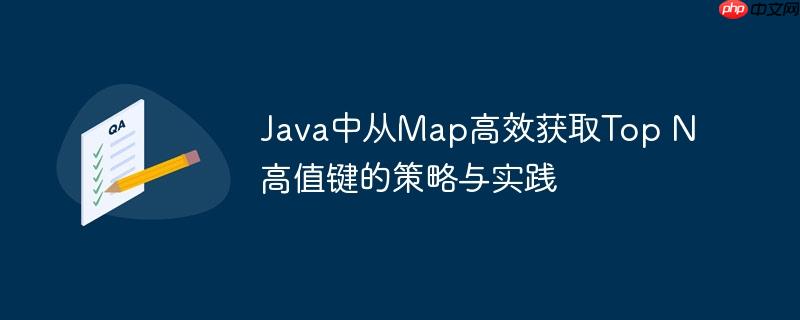
在Java开发中,我们经常会遇到需要从一个Map<K, V>中提取出部分键(K),这些键的特点是它们对应的关联值(V)是Map中最高的N个。例如,我们可能有一个Map<Person, Integer>,其中Person是键,Integer代表该人物的得分,我们需要找出得分最高的N个人。
解决此问题的关键在于:
这种方法是解决此类问题的直观且常用的方式。其核心思想是将Map的键值对(Map.Entry)集合转换为一个List,然后对这个列表进行排序,最后截取排序后的前N个元素。
为了演示,我们创建一个简单的Person类作为Map的键。
立即学习“Java免费学习笔记(深入)”;
import java.util.*;
import java.util.stream.Collectors;
public class TopNKeysFromMap {
// 示例Person类,作为Map的键
static class Person {
String name;
public Person(String name) { this.name = name; }
@Override
public String toString() { return "Person(" + name + ")"; }
// 重写equals和hashCode方法,确保Person对象作为Map键的正确性
@Override
public boolean equals(Object o) {
if (this == o) return true;
if (o == null || getClass() != o.getClass()) return false;
Person person = (Person) o;
return Objects.equals(name, person.name);
}
@Override
public int hashCode() { return Objects.hash(name); }
}
/**
* 使用经典方法从Map中获取Top N高值键
* @param map 待处理的Map
* @param n 需要获取的Top N数量
* @return 包含Top N键的列表
*/
public static List<Person> getTopNKeysClassic(Map<Person, Integer> map, int n) {
// 1. 获取Map的entrySet并转换为ArrayList
List<Map.Entry<Person, Integer>> entries = new ArrayList<>(map.entrySet());
// 2. 使用Collections.sort和Comparator进行降序排序
// Comparator.comparing(Map.Entry::getValue) 默认是升序
// .reversed() 将排序顺序反转为降序
Collections.sort(entries, Comparator.comparing(Map.Entry::getValue).reversed());
// 3. 截取前N个元素,并提取键
// 确保N不超过Map的实际大小,避免IndexOutOfBoundsException
int limit = Math.min(n, entries.size());
List<Person> topNPeople = new ArrayList<>();
for (int i = 0; i < limit; i++) {
topNPeople.add(entries.get(i).getKey());
}
return topNPeople;
}
public static void main(String[] args) {
Map<Person, Integer> scores = new HashMap<>();
scores.put(new Person("Alice"), 95);
scores.put(new Person("Bob"), 88);
scores.put(new Person("Charlie"), 92);
scores.put(new Person("David"), 78);
scores.put(new Person("Eve"), 98);
scores.put(new Person("Frank"), 85);
// 获取Top 3得分最高的Person
List<Person> top3People = getTopNKeysClassic(scores, 3);
System.out.println("经典方法 - Top 3 人员: " + top3People); // 预期:Eve, Alice, Charlie (顺序可能因相同分数而异)
// 获取Top 5得分最高的Person (Map中只有6个,N=5)
List<Person> top5People = getTopNKeysClassic(scores, 5);
System.out.println("经典方法 - Top 5 人员: " + top5People);
// 获取Top 10得分最高的Person (N > Map.size())
List<Person> top10People = getTopNKeysClassic(scores, 10);
System.out.println("经典方法 - Top 10 人员: " + top10People);
}
}Java 8引入的Stream API为集合操作提供了更声明式、更简洁的风格。使用Stream API处理Top N问题,代码将更加优雅。
继续使用上面的TopNKeysFromMap类:
// ... (在TopNKeysFromMap类中添加此方法)
/**
* 使用Java 8 Stream API从Map中获取Top N高值键
* @param map 待处理的Map
* @param n 需要获取的Top N数量
* @return 包含Top N键的列表
*/
public static List<Person> getTopNKeysStream(Map<Person, Integer> map, int n) {
return map.entrySet().stream()
// 1. 按照值降序排序
.sorted(Map.Entry.<Person, Integer>comparingByValue().reversed())
// 2. 限制为前N个元素
.limit(n)
// 3. 提取键
.map(Map.Entry::getKey)
// 4. 收集为List
.collect(Collectors.toList());
}
public static void main(String[] args) {
// ... (同上,定义scores Map)
System.out.println("\n--- Stream API 方法 ---");
List<Person> top3PeopleStream = getTopNKeysStream(scores, 3);
System.out.println("Stream API - Top 3 人员: " + top3PeopleStream);
List<Person> top5PeopleStream = getTopNKeysStream(scores, 5);
System.out.println("Stream API - Top 5 人员: " + top5PeopleStream);
List<Person> top10PeopleStream = getTopNKeysStream(scores, 10);
System.out.println("Stream API - Top 10 人员: " + top10PeopleStream);
}当Map的规模非常大,而N相对较小(例如,从百万条数据中找出Top 10),此时对整个Map进行排序的O(M log M)复杂度会非常高。在这种情况下,使用PriorityQueue(优先队列)可以提供更好的性能,其时间复杂度为O(M log N)。
// ... (在TopNKeysFromMap类中添加此方法)
/**
* 使用PriorityQueue从Map中获取Top N高值键
* @param map 待处理的Map
* @param n 需要获取的Top N数量
* @return 包含Top N键的列表
*/
public static List<Person> getTopNKeysPriorityQueue(Map<Person, Integer> map, int n) {
if (n <= 0) {
return Collections.emptyList();
}
// 创建一个大小为N的最小堆,用于存储Map.Entry
// 比较器按照值(Integer)升序排列,确保堆顶是最小值
PriorityQueue<Map.Entry<Person, Integer>> minHeap = new PriorityQueue<>(
Comparator.comparing(Map.Entry::getValue)
);
for (Map.Entry<Person, Integer> entry : map.entrySet()) {
if (minHeap.size() < n) {
minHeap.offer(entry); // 如果堆未满,直接加入
} else if (entry.getValue() > minHeap.peek().getValue()) {
// 如果当前值大于堆顶(当前Top N中最小的值),则移除堆顶,加入当前值
minHeap.poll();
minHeap.offer(entry);
}
}
// 将堆中的元素提取出来。因为是最小堆,所以提取出来的顺序是升序的,需要反转
List<Person> topNKeys = new ArrayList<>();
while (!minHeap.isEmpty()) {
topNKeys.add(minHeap.poll().getKey());
}
Collections.reverse(topNKeys); // 反转列表以获得降序结果
return topNKeys;
}
public static void main(String[] args) {
// ... (同上,定义scores Map)
System.out.println("\n--- PriorityQueue 方法 ---");
List<Person> top3PeoplePQ = getTopNKeysPriorityQueue(scores, 3);
System.out.println("PriorityQueue - Top 3 人员: " + top3PeoplePQ);
List<Person> top5PeoplePQ = getTopNKeysPriorityQueue(scores, 5);
System.out.println("PriorityQueue - Top 5 人员: " + top5PeoplePQ);
List<Person> top10PeoplePQ = getTopNKeysPriorityQueue(scores, 10);
System.out.println("PriorityQueue - Top 10 人员: " + top10PeoplePQ);
}| 方法 | 时间复杂度 | 空间复杂度 | 优点 | 缺点 | 适用场景 |
|---|
以上就是Java中从Map高效获取Top N高值键的策略与实践的详细内容,更多请关注php中文网其它相关文章!

每个人都需要一台速度更快、更稳定的 PC。随着时间的推移,垃圾文件、旧注册表数据和不必要的后台进程会占用资源并降低性能。幸运的是,许多工具可以让 Windows 保持平稳运行。

Copyright 2014-2025 https://www.php.cn/ All Rights Reserved | php.cn | 湘ICP备2023035733号